Micro-ATX Cases - Shoebox Showdown
by Joshua Buss on January 2, 2007 12:40 PM EST- Posted in
- Cases/Cooling/PSUs
Antec Aria - Exterior
We've had requests to look at the Aria for well over a year now, but only recently were we able to get enough micro-ATX cases to compare against each other for a full-fledged review. Normally our policy on taking pictures of packaging is that we'd expect any manufacturer to protect their product substantially, and we will only make mention of a product's particular packaging job if it's deplorable or substantially better than average. With the small Aria, we were very happy to see Antec using soft foam blocks rather than typically messy Styrofoam or peanuts, and immediately we had a sense that this case was incredibly tough due to its weight for such a small unit.
The Aria reminded us of the P180 very much - only obviously much smaller - primarily due to its multi-material construction. The frame of the case is mostly steel, but aluminum and plastic are both used for panels and trim pieces. The simple front gives the first clue that the case is smaller than most mATX PCs and even many proprietary SFFs, as it is designed to hold only a single optical drive. There are a couple other key points about the front. All three buttons are plastic but still have a good feel, and the front ports are all nicely spaced apart for larger devices. HDD activity is shown with a blue LED to the right of the reset button, and as long as the system is powered on blue LEDs shine up from the bottom of the slits on the left and right side.
More than just about any other mATX case, the Aria really does resemble a large shoebox in its dimensions. However,,its looks are a little more interesting than dual-tone cardboard. We really like the look the black trim gives the case, and the ribbed top is an interesting touch we've come to appreciate. This top cover is plastic on the top and metal underneath including its grill above the PSU, and the equally hefty side panels are plastic inside and around the edges to dampen vibrations. Thanks to the combination of materials the case is quite resilient to fingerprints for the most part, but the exposed aluminum on the sides is not your typical brushed anodized finish and can pick up smudges or scratches a little easier.
Taking a closer look at the back we can get a sense of the custom-made PSU which allows the Aria to be so compact. Sporting a large fan, the PSU will be able to move plenty of air through the small case without making too much noise. Expansion card retention is done with two standard case screws for a special bracket and one screw for the card itself.
The right side of the case has an impression of "Antec" in the lower right corner and contains the same ventilation perforations as the other side along the bottom. The case's feet are soft rubber and add to the total sound dampening effect as well as keep it from sliding around like some wheeled cases.
More information on the Aria is available on Antec's website.
We've had requests to look at the Aria for well over a year now, but only recently were we able to get enough micro-ATX cases to compare against each other for a full-fledged review. Normally our policy on taking pictures of packaging is that we'd expect any manufacturer to protect their product substantially, and we will only make mention of a product's particular packaging job if it's deplorable or substantially better than average. With the small Aria, we were very happy to see Antec using soft foam blocks rather than typically messy Styrofoam or peanuts, and immediately we had a sense that this case was incredibly tough due to its weight for such a small unit.
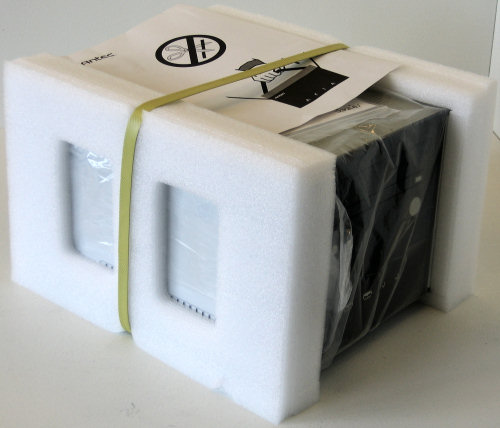 |
| Click to enlarge |
The Aria reminded us of the P180 very much - only obviously much smaller - primarily due to its multi-material construction. The frame of the case is mostly steel, but aluminum and plastic are both used for panels and trim pieces. The simple front gives the first clue that the case is smaller than most mATX PCs and even many proprietary SFFs, as it is designed to hold only a single optical drive. There are a couple other key points about the front. All three buttons are plastic but still have a good feel, and the front ports are all nicely spaced apart for larger devices. HDD activity is shown with a blue LED to the right of the reset button, and as long as the system is powered on blue LEDs shine up from the bottom of the slits on the left and right side.
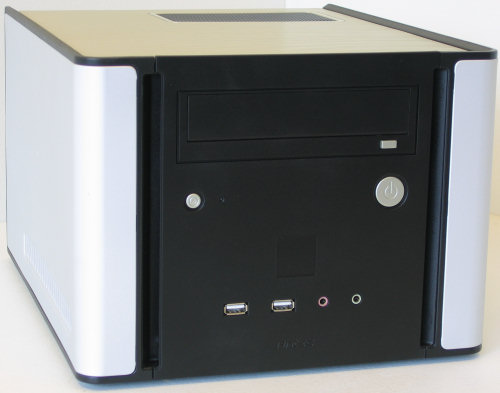 |
| Click to enlarge |
More than just about any other mATX case, the Aria really does resemble a large shoebox in its dimensions. However,,its looks are a little more interesting than dual-tone cardboard. We really like the look the black trim gives the case, and the ribbed top is an interesting touch we've come to appreciate. This top cover is plastic on the top and metal underneath including its grill above the PSU, and the equally hefty side panels are plastic inside and around the edges to dampen vibrations. Thanks to the combination of materials the case is quite resilient to fingerprints for the most part, but the exposed aluminum on the sides is not your typical brushed anodized finish and can pick up smudges or scratches a little easier.
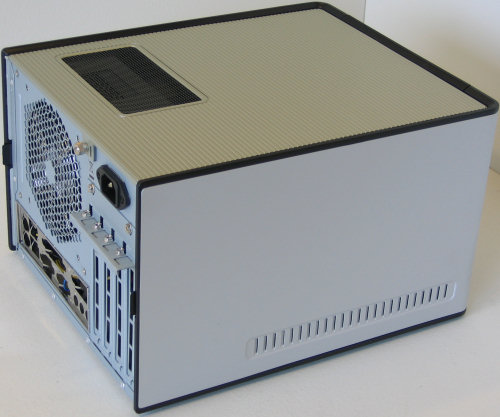 |
| Click to enlarge |
Taking a closer look at the back we can get a sense of the custom-made PSU which allows the Aria to be so compact. Sporting a large fan, the PSU will be able to move plenty of air through the small case without making too much noise. Expansion card retention is done with two standard case screws for a special bracket and one screw for the card itself.
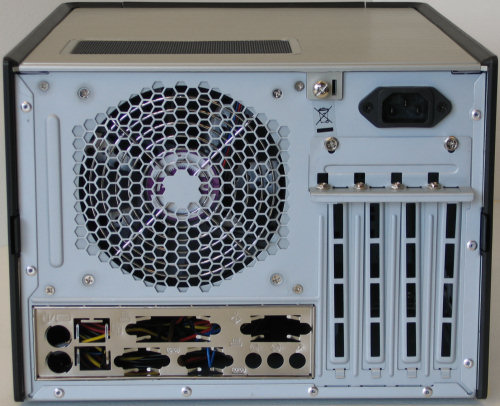 |
| Click to enlarge |
The right side of the case has an impression of "Antec" in the lower right corner and contains the same ventilation perforations as the other side along the bottom. The case's feet are soft rubber and add to the total sound dampening effect as well as keep it from sliding around like some wheeled cases.
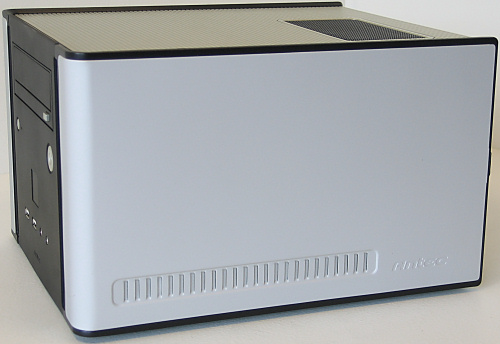 |
| Click to enlarge |
More information on the Aria is available on Antec's website.










37 Comments
View All Comments
chucky2 - Tuesday, January 2, 2007 - link
:) Just asking...AlexWade - Tuesday, January 2, 2007 - link
Dear Anandtech staff:Please do more case reviews.
Signed,
Everyone
microAmp - Tuesday, January 2, 2007 - link
I'd like to see them do a review using video instead of text & pictures. I saw one other website do that and it's make a world of difference. Wish I could remember what site it was. :(JoshuaBuss - Tuesday, January 2, 2007 - link
Besides placing an excruciating load on the web servers, I think highly-detailed pictures are better than videos at least in terms of seeing exactly how things look. It's hard to get colors just right in videos, and resolution is normally low enough that some fine details are lost.. I can see where you're coming from though and we'll definitely consider it.. actually seeing things in motion can help get a better feel for some things.mino - Thursday, January 4, 2007 - link
Maybe host them on YouTube ? and consider them just a bonus to regular review...JoshuaBuss - Tuesday, January 2, 2007 - link
Copy that.. ;)In all seriousness, you can expect this section to get a lot hotter soon.. I just finished my last semester of coursework.. w00t.
SonixSquad - Wednesday, September 7, 2011 - link
Just wanted to post my experience having built my girlfriend a system about 5 years ago using the Antec Aria case.I remember it being a pain as it was so cramped and my first (and only) sff build but I got there and it was adequate. I managed to install the board without removing the PSU.
Once I started to monitor temps (was only using stock cpu cooler at the time) I realised it would need some sort of additional cooling intake and the supplied blower was a bit too loud for our liking.
Eventually I found the best air intake solution (without actually modding the case) was to just put a 120mm fan sitting next to the graphics card pulling air in from the rear.
Anyway, back to today 2011 and she still likes the case but the system needs an upgrade so I was looking at parts and having come across this article and seen the Zalman in there snugly fitting with a few mm clear of the PSU I decided to get the newer Zalman CNPS8000A which is low profile and supposedly quiet. I'll post back if it doesn't fit but I think I am going to have to remove the PSU this time around as this cooler needs to be fitted via backplate so it will have to go on before the board is in the case.
This time round she is getting an i3 2100 cpu which should run a lot cooler than the last AMD x2 one and so I'm hoping it will run a lot quieter aswell.
My criticisms about the case would be the same as noted by others. Very cramped and with a lack of decent routing the air circulation is bad. I would have appreciated some thought given to front air intake even if they didn't supply a fan but just somewhere to put one.
Also the PSU only comes with one SATA connector so I will have to get a molex to sata converter so I can power 2 sata devices.I also had some issues with the front audio inputs, at some point they stopped working properly and I still don't know why.